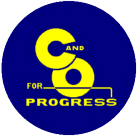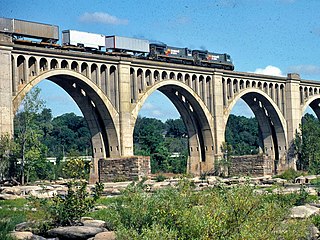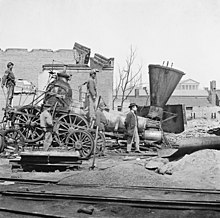
CSX Transportation, known colloquially as simply CSX, is a Class I freight railroad company operating in the Eastern United States and the Canadian provinces of Ontario and Quebec. The railroad operates on approximately 21,000 route miles (34,000 km) of track. The company operates as the leading subsidiary of CSX Corporation, a Fortune 500 company headquartered in Jacksonville, Florida.

The Seaboard Coast Line Railroad was a Class I railroad company operating in the Southeastern United States beginning in 1967. Its passenger operations were taken over by Amtrak in 1971. Eventually, the railroad was merged with its affiliate lines to create the Seaboard System in 1983.

The Chesapeake and Ohio Railway was a Class I railroad formed in 1869 in Virginia from several smaller Virginia railroads begun in the 19th century. Led by industrialist Collis P. Huntington, it reached from Virginia's capital city of Richmond to the Ohio River by 1873, where the railroad town of Huntington, West Virginia, was named for him.

"Juice Train" is the popular name for unit trains of Tropicana fresh orange juice operated by railroads in the United States.

The Seaboard Air Line Railroad, which styled itself as "The Route of Courteous Service", was an American railroad that existed from April 14, 1900, until July 1, 1967, when it merged with the Atlantic Coast Line Railroad, its longtime rival, to form the Seaboard Coast Line Railroad. Predecessor railroads dated from the 1830s and reorganized extensively to rebuild after the American Civil War. The company was headquartered in Norfolk, Virginia, until 1958, when its main offices were relocated to Richmond, Virginia. The Seaboard Air Line Railway Building in Norfolk's historic Freemason District still stands and has been converted into apartments.

The Richmond, Fredericksburg, and Potomac Railroad was a railroad connecting Richmond, Virginia, to Washington, D.C. The track is now the RF&P Subdivision of the CSX Transportation system; the original corporation is no longer a railroad company.

The Atlantic Coast Line Railroad was a United States Class I railroad formed in 1900, though predecessor railroads had used the ACL brand since 1871. In 1967, it merged with long-time rival Seaboard Air Line Railroad to form the Seaboard Coast Line Railroad. Much of the original ACL network has been part of CSX Transportation since 1986.

The Louisville and Nashville Railroad, commonly called the L&N, was a Class I railroad that operated freight and passenger services in the southeast United States.
The Petersburg Railroad ran from Petersburg, Virginia, south to Garysburg, North Carolina, from which it ran to Weldon via trackage rights over the Seaboard and Roanoke Railroad.

The CSX A-Line Bridge is a double-track concrete bridge that carries the North End Subdivision of CSX Transportation over the James River in Richmond, Virginia. The bridge was built jointly by the Atlantic Coast Line Railroad and Richmond, Fredericksburg and Potomac Railroad in 1919. Designed by John E. Greiner, this bridge was one of many he drew up for the RF&P, and brought early success to his recently established private consulting business. The purpose of this "million dollar bridge" was to create a quicker, more direct route around Richmond by passing over east–west tracks on both sides of the river.

The Richmond and Petersburg Railroad Bridge was a bridge that carried the Richmond and Petersburg Railroad and several later railroads including the Atlantic Coast Line Railroad and the Seaboard Coast Line Railroad over the James River in Richmond, Virginia. It was first built in 1838 and after going through four different bridges was finally torn down in 1970.
The RF&P Subdivision is a railroad line operated by CSX Transportation and jointly owned by CSX and Virginia. It runs from Washington, D.C., to Richmond, Virginia, over lines previously owned by the Pennsylvania Railroad and the Richmond, Fredericksburg and Potomac Railroad. The line's name pays homage to that railroad, which was a predecessor to the CSX.

In 1886, Randolph Harrison, of the Virginia department of Agriculture, cited Cumberland Mining Company, stating that the United States had purchased stock in the Brighthope Railway. He continued by citing their assertion that extending the railway into Cumberland would increase the value of farms there because they could sell consumer agricultural products such as fruit, dairy and vegetables to all markets of Virginia. The Brighthope Railway was founded in 1877 by the creditors of the Clover Hill Railroad who bought that railroad when the Clover Hill Railroad went bankrupt. The Brighthope Railway continued in the role of the Clover Hill Railroad, hauling coal from the Clover Hill Pits at Winterpock, Virginia. In addition to coal, the Bright Hope Railway transported timber and agricultural products and had passenger service. The Bright Hope Railway was narrowed from standard gauge to narrow gauge and rerouted in 1881. In 1886, much of the southern rails were changed to standard gauge. The Brighthope Railway was not changed back.

In 1886, Randolph Harrison, of the Virginia department of Agriculture, cited Cumberland Mining Company, stating that businessmen would soon open a hotel at Lithia Springs, Farmville, VA for people seeking the healing waters. The Brighthope railway would be extended to bring them there. But instead, the Farmville and Powhatan Railroad Company built the narrow gauge rails through Cumberland County and the Farmville and Powhatan Railroad Company bought the Brighthope Railway, so the Farmville and Powhatan Railroad made the connection. In 1890, Beach Station was built with a railroad depot, some railroad shanties, a general store and an owner's house, the George Perdue House as a stop on the line.

The North End Subdivision is a railroad line owned by CSX Transportation in Virginia and North Carolina. The line runs from Richmond, Virginia, to Rocky Mount, North Carolina, for a total of 123.2 miles. At its north end the line continues south from the Richmond Terminal Subdivision and at its south end the line continues south as the South End Subdivision. The North End Subdivision is the northernmost segment of CSX's A Line which in its entirety runs from Richmond to Tampa, Florida. Some of the line's notable features include running in the median of Interstate 195 in Richmond as well as the line's tall arch bridge over the James River.
The Norlina Subdivision is a railroad line owned by CSX Transportation in the U.S. State of North Carolina. The line currently runs from Norlina, North Carolina, to Raleigh, North Carolina, for a total of 51.2 miles. At its north end the line comes to an end and at its south end the line continues north from the Aberdeen Subdivision. While the current line dates back to 1840, it has been known as the Norlina Subdivision since the 1970s. Under CSX's predecessor, the Seaboard Coast Line Railroad, the Norlina Subdivision continued north to Collier Yard near Petersburg, Virginia.
The Portsmouth Subdivision is a railroad line owned by CSX Transportation in Virginia and North Carolina. The line connects CSX's network with the port city of Portsmouth, Virginia. The Portsmouth Subdivision was historically operated by the Seaboard Air Line Railroad, a CSX predecessor.
The Richmond, Petersburg and Carolina Railroad was a railroad built in the early 1900s. As its name suggests, it ran from Richmond, Virginia south through Petersburg into northern North Carolina. It was a key part of the network of the Seaboard Air Line Railroad.

The Atlantic Coast Line Railroad’s Main Line was the backbone of the Atlantic Coast Line Railroad's network in the southeastern United States. The main line ran from Richmond, Virginia to Port Tampa just southwest of Tampa, Florida, a distance of nearly 900 miles. Along its route it passed through Petersburg, Rocky Mount, Florence, Charleston, Savannah, Jacksonville, and Orlando. With the exception of a short 61-mile segment in Greater Orlando, the entire line is still owned by the Atlantic Coast Line's successor, CSX Transportation, and is still in service as their A Line.
The Seaboard Air Line Railroad’s Main Line was the backbone of the Seaboard Air Line Railroad's network in the southeastern United States. The main line ran from Richmond, Virginia to Tampa, Florida, a distance of over 800 miles. Along its route it passed through Petersburg, Raleigh, Columbia, Savannah, Jacksonville, and Ocala, Florida. While some segments of the line have been abandoned as of 2022, most of the line is still in service and is owned by the Seaboard Air Line's successor, CSX Transportation as their S Line.





















